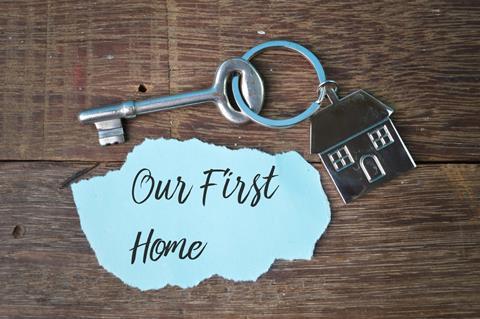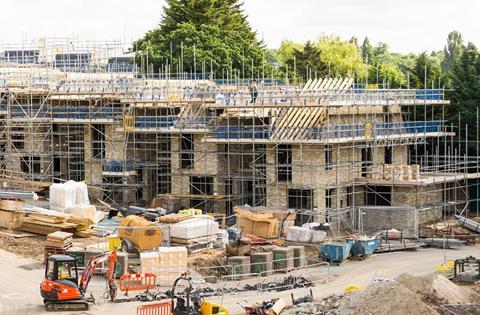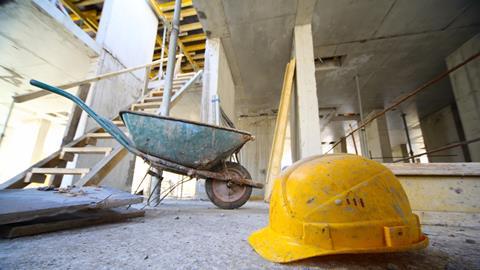The final applications have been submitted and the governmentŌĆÖs controversial equity loan scheme in England is due to wind up on 31 March next year, despite the current economic crisis. Emily Twinch considers what impact this will have on housebuilders and their delivery of new homes
It is fair to say that Help to Buy has been something of a Marmite government scheme. Beloved by builders, who say it has increased supply of homes, its detractors claim it has driven up property prices.
Meeting Housing Demand, a House of Lords report released in January this year, concluded that Help to Buy ŌĆ£inflates prices by more than its subsidy value in areas where it is needed the mostŌĆØ. Financial Times columnist Neil Collins called the scheme ŌĆ£Help to Buy Yachts for housebuilding executivesŌĆØ in a column in 2018.
Whatever the view, the scheme, for which final applications had to be in by the end of last month ŌĆō and which will have cost the government around ┬Ż29bn when it ends in March next year ŌĆō has increased supply and enjoyed a huge take-up among buyers, particularly those stepping onto the housing ladder for the first time.
The Home Builders Federation (HBF) says that it has generated about ┬Ż60bn in economic activity. The number of homes built in England went up from 110,530 in the year to June 2013 ŌĆō the year that Help to Buy was introduced ŌĆō to 183,450 in the 12 months to June 2021, government figures show.
The Department for Levelling Up, Housing and Communities (DLUHC) said the scheme has helped 369,000 households to buy their own home so far.
Certainly, the equity loan scheme, which enables buyers to buy with a 5% deposit using an equity loan worth 20% of the price of a new build home (40% in London), has been popular with housebuilders. Help to Buy will account for around 20% of many housebuildersŌĆÖ total sales this year [see table below].
And, while this is down from figures in excess of 30% and 40% in the past couple of years, [see timeline below], that is still a sizable chunk of property sold.
HousebuildersŌĆÖ Help to Buy Sales
| Total proportion of sales made up by Help to Buy units in each year | ||||
|
Housebuilder |
2019 |
2020 |
2021 |
2022 |
|
Barratt |
35% |
38% |
19% |
|
|
Bellway |
35% |
39% |
22% |
|
|
Countryside |
20% |
20% |
23% |
|
|
Crest Nicholson |
35% |
30% |
|
|
|
Persimmon |
48% |
34% |
20% |
|
|
Redrow |
33% |
28% |
8.6% |
|
|
Taylor Wimpey |
34% |
46% |
19% |
20% |
|
Vistry |
|
36% |
21% |
|
Source:individual housebuilders responses / annual financial statements
So, how do housebuilders plan to replace those house sales, if indeed they are going to do so? And how is the change likely to impact them, at a time of high inflation and mortgage rate rises?
Not a good time
Neil Jefferson, managing director of the HBF, believes that Help to Buy has been one of ŌĆ£the most successful government home ownership interventions in history and handsomely delivered on all its pre-set objectivesŌĆØ. He argues that this is not the right time to pull the scheme.
ŌĆ£For the first time in decades, there is now no government scheme in place to support first-time buyers to purchase new homes at a time when political and economic instability has seen mortgage availability challenged,ŌĆØ Jefferson explains.
The National Federation of Builders (NFB) also does not believe this is a good time to end the scheme. Rico Wojtulewicz, its head of housing and planning policy, says: ŌĆ£We have lobbied the government to keep Help to Buy and reform it in a way to ensure it supports certain criteria, such as higher energy-efficient housing, on smaller plot sizes of houses only, or to help specific people who struggle the most to borrow, such as families needing bigger homes or single people.ŌĆØ

Brian Berry, chief executive of the Federation of Master Builders (FMB), believes ŌĆ£the ending of the Help to Buy scheme could exacerbate an already troubled marketŌĆØ.
The FMB would like to see the government bring forward a policy that would mitigate the loss of revenue from Help to Buy, by providing investment to planning authorities so schemes can be approved more quickly.
ŌĆ£For the first time in decades there is now no government scheme in place to support first-time buyers to purchase new homes at a time where political and economic instability has seen mortgage availability challengedŌĆØ
Neil Jefferson, HBF
Tony Williams, chief executive of the consultancy firm ║┌Č┤╔ńŪ° Value, believes it is a ŌĆ£really unfortunate timeŌĆØ to pull the scheme. ŌĆ£I was sceptical when it was launched but it has played a blinder,ŌĆØ he says, adding that it has been ŌĆ£a real fillip to industry.ŌĆØ
He thinks it would be a good idea for the government to ŌĆ£bring something else out to replace itŌĆØ, although he admits that this might prove ŌĆ£politically difficultŌĆØ at the moment.
However, Neil Hudson, founder of Residential Analysts, thinks the scheme should have been abandoned years ago. ŌĆ£ItŌĆÖs never a good time,ŌĆØ he says. While it has done ŌĆ£a good jobŌĆØ, he adds: ŌĆ£The reality is, we should have stopped Help to Buy years ago because there was a danger the market became dependent on the scheme.ŌĆØ
Housebuilders should have been ŌĆ£weaned off it years agoŌĆØ and Hudson believes the government should ŌĆ£be looking to see what it can instead do to maintain capacity in the housebuilding sectorŌĆØ.
The fall-out

But, if the government does not do anything to replace the money that Help to Buy would have brought in, analysts are sure that it will lead to a drop in the number of homes built. While the higher mortgage rates and rising costs because of inflation pose a bigger problem, Help to Buy is definitely expected to exacerbate it.
Berry says: ŌĆ£We have seen workloads among our housebuilding members drop as the year has progressed and members reported in our latest State of Trade survey that they have seen a drop-off in enquiries.ŌĆØ
Lucian Cook, head of UK residential research at Savills, agrees. With the scheme being dropped at a ŌĆ£time of great uncertaintyŌĆØ, he now expects it to ŌĆ£contribute to a decline in housing delivery over the next 18 to 24 monthsŌĆØ.
Ross Smith, director at new-build sales and marketing business SiteSales, adds: ŌĆ£Without the Help to Buy scheme, volumes will inevitably drop unless extended or a combination of the government and housebuilders collaborate to create alternative buying options.ŌĆØ
Williams echoes this. ŌĆ£We are going to have dramatically falling numbers of buyers and cancellations,ŌĆØ he says. ŌĆ£[Build] volumes are going to fall significantly.ŌĆØ
But the end of Help to Buy is not only going to affect housebuilders. There is also the social impact of wannabe buyers having to spend longer in rented housing to consider. This may not go unnoticed by new prime minister Rishi Sunak, to make ŌĆ£home ownership a reality for a new generationŌĆØ.
A Royal Institution of Chartered Surveyors monthly residential survey this month pointed out that house price growth was ŌĆ£grinding to a haltŌĆØ while the lettings market is growing. Williams said it will now be harder for a young couple to get a foot on the housing ladder. ŌĆ£People will be living at home for longer, or team up and youŌĆÖll get more than one person living in a house,ŌĆØ he suggests. And there will also be a greater reliance on the ŌĆ£bank of mum and dadŌĆØ.
Cullen agrees: ŌĆ£More people will have to stay in the rental sector and their ability to save for a deposit will be impaired.ŌĆØ
Wojtulewicz explains: ŌĆ£With fewer people being able to access mortgages, the housing crisis will no doubt worsen as people continue to pay more in rent, live with parents longer or in overcrowded homes.ŌĆØ
However, the head of housing and planning policy at the NFB feels that any drop in purchases is likely to have a greater impact on larger builders with vacant stock than smaller builders who would ŌĆ£likely change their housing typology to attract different buyersŌĆØ.
What the builders have been doing

So what are housebuilders planning? Wojtulewicz thinks SME builders are likely to have been ŌĆ£pivoting to smaller propertiesŌĆØ.
But he suggests: ŌĆ£Big builders will certainly be analysing which regions hold better opportunities.ŌĆØ
Of course, builders are likely to have already been choosing to build homes in areas that would yield the greatest return since the Help to Buy restrictions came in last year, as they introduced regional purchase price caps [see timeline below].
Hudson says builders have been ŌĆ£shifting their activity from markets and product types that were coming in above the regional price capsŌĆØ. He explains they have been ŌĆ£shifting away from first-time buyers and selling to people moving onŌĆØ.
Indeed, builders themselves, who have known for a while that Help to Buy would end, say they have been preparing for the moment. RedrowŌĆÖs Help to Buy sales this year were just 8.6% compared with 28% last year.
A spokesperson for the developer told Ą■│▄Š▒▒¶╗ÕŠ▒▓į▓ĄŌĆÖs sister title Housing Today: ŌĆ£We have successfully transitioned away from the scheme without any impact on our reservations.ŌĆØ
They added: ŌĆ£This reflects the strategic advantage of our award-winning Heritage Collection, which is predominately made up of three to four-bedroom detached homes with an average private sales price above the Help to Buy threshold.ŌĆØ
Help to Buy has made up about 20% of PersimmonŌĆÖs total sales in the year to date. A spokesperson said: ŌĆ£We believe our unique value proposition will provide an enduring strength in an uncertain market. Our lower average selling price, combined with the cost advantage of new homesŌĆÖ 30% energy efficiency premium above existing housing stock, will prove attractive.ŌĆØ
In Taylor WimpeyŌĆÖs annual report for last year the firm said: ŌĆ£We have been preparing for this change [the end of Help to Buy] for some time, and this is reflected in our landbuying approach, site selection and in the design of our developments.
ŌĆ£For example, in certain areas, we have plotted sites to include a greater weighting of three-bedroom than four or five-bedroom homes reflecting expected market demand.ŌĆØ
Options, options
There are, of course, other mortgage schemes available, even if they are not so generous. Taylor Wimpey also points out in its 2021 report that it will be using Deposit Unlock on a small number of its new-builds in England and Scotland.
This scheme, developed by housebuilders, provides ŌĆ£competitive rate mortgagesŌĆØ to customers with a 5% deposit. ŌĆ£[It] is expected to be appealing to customers when Help to Buy ends in England in March 2023,ŌĆØ the Taylor Wimpey report says.
Wojtulewicz explains: ŌĆ£There are other products on the market trying to fill the gap left by Help to Buy.ŌĆØ One of these, he says, is the Capita-backed market mortgage, ŌĆ£which provides a 95% mortgage, albeit at slightly higher rates.ŌĆØ
The DLUHC says it has ŌĆ£introduced a range of flexible home ownership schemes to help young people on to the housing ladder and we keep all options to increase home ownership under reviewŌĆØ.
These schemes include shared ownership and its First Homes scheme, offering discounted homes to local first-time buyers. There have however been concerns in the past expressed that developers would not be keen to deliver First Homes.
A DLUHC spokesperson said: ŌĆ£Help to Buy has supported over 369,000 households into homeownership. It is just one of the many ways the government has made owning a home more achievable as we continue to help more first-time buyers.ŌĆØ
Help to Buy: a timeline
April 2013 Two Help to Buy schemes are announced by then-chancellor George Osborne in the Budget for first-time buyers and those moving home. One allowed purchases to buy new-build homes with a 5% deposit; the lender would give 75% and the government an ŌĆ£equity loanŌĆØ up to 20% the value of the property.
The second part meant lenders could offer mortgages to people with between 5% and 20% deposit as the government made ┬Ż12bn of guarantees to lenders.
September 2016 The government announces it will not be extending the Help to Buy mortgage guarantee scheme into 2017.
October 2018 The government announces that the Help to Buy equity loan scheme will run from 1 April 2021 until 31 March 2023.
April 2021 Tighter restrictions are brought in to ensure the equity loan scheme is only for first-time buyers. The government introduces regional purchase price caps based on 1.5 times the average regional first-time buyer price, ranging from ┬Ż186,100 in the North-east to ┬Ż600,000 in London.
31 October 2022 Scheme closes to new applicants.
31 March 2023 Scheme ends.
Cook suggests that there may be an extension of the mortgage guarantee scheme, where lenders are encouraged to offer 95% mortgages through a government-backed guarantee. The scheme is due to end on 31 December this year.
Cullen also says there has been ŌĆ£more talk around the mortgage indemnity schemeŌĆØ. He said the government could go back to this. ŌĆ£I would be surprised if the government doesnŌĆÖt do something to support the market,ŌĆØ he adds.
>> See also: Housebuilders say ŌĆśbitterly disappointingŌĆÖ autumn statement does nothing to help sector
Cook believes there will be a greater need for private rental stock in the market and, becasue there was a ŌĆ£strong wall of moneyŌĆØ going towards built-to-rents, this sector may see a rise in growth. He pointed out, however, that BTR developers needed to ŌĆ£understand the returnsŌĆØ and it could cost more to build properties with guilt yields rising.
Hudson also thinks housebuilders could turn to ŌĆ£private equity and other sources of equity to build in the build-to-rent marketŌĆØ. He says there would be ŌĆ£a lot of interest from big institutional investorsŌĆØ in this.
Whatever happens, people will miss Help to Buy. Wojtulewicz says: ŌĆ£Buyers still come in and ask whether they can access it, so it remains a well-known, enticing product.ŌĆØ
But there appears to be no political appetite to keep it going or replace it at present. Which means, while high mortgage rates and inflation costs are inevitably going to cause the greatest trouble, the end of Help to Buy is certainly going to contribute to a housing market downturn.
A Fair Deal for Housing campaign

Ą■│▄Š▒▒¶╗ÕŠ▒▓į▓ĄŌĆÖs sister publication Housing Today believes the government should not back away from its manifesto pledge of building 300,000 new homes a year by the middle of the decade. We badly need more homes and a lack of supply is a major factor in creating problems of affordability for both buyers and renters.
Over the next few months, Housing Today will be exploring potential solutions to help us ramp up housebuilding to 300,000. These are likely to, include different ways of working, funding asks of government and policy ideas that could boost housebuilding.
We want to hear from you: what do you think can make a difference at a policy level?
What can the industry do better?
We believe that, with the right commitments from ministers and the industry, it is possible to build more homes and help the government to meet its objectives to ŌĆ£build beautifulŌĆØ, improve quality and safety, boost home ownership and level up the UK.
To contribute ideas to our A Fair Deal for Housing Ideas Zone database,




























No comments yet